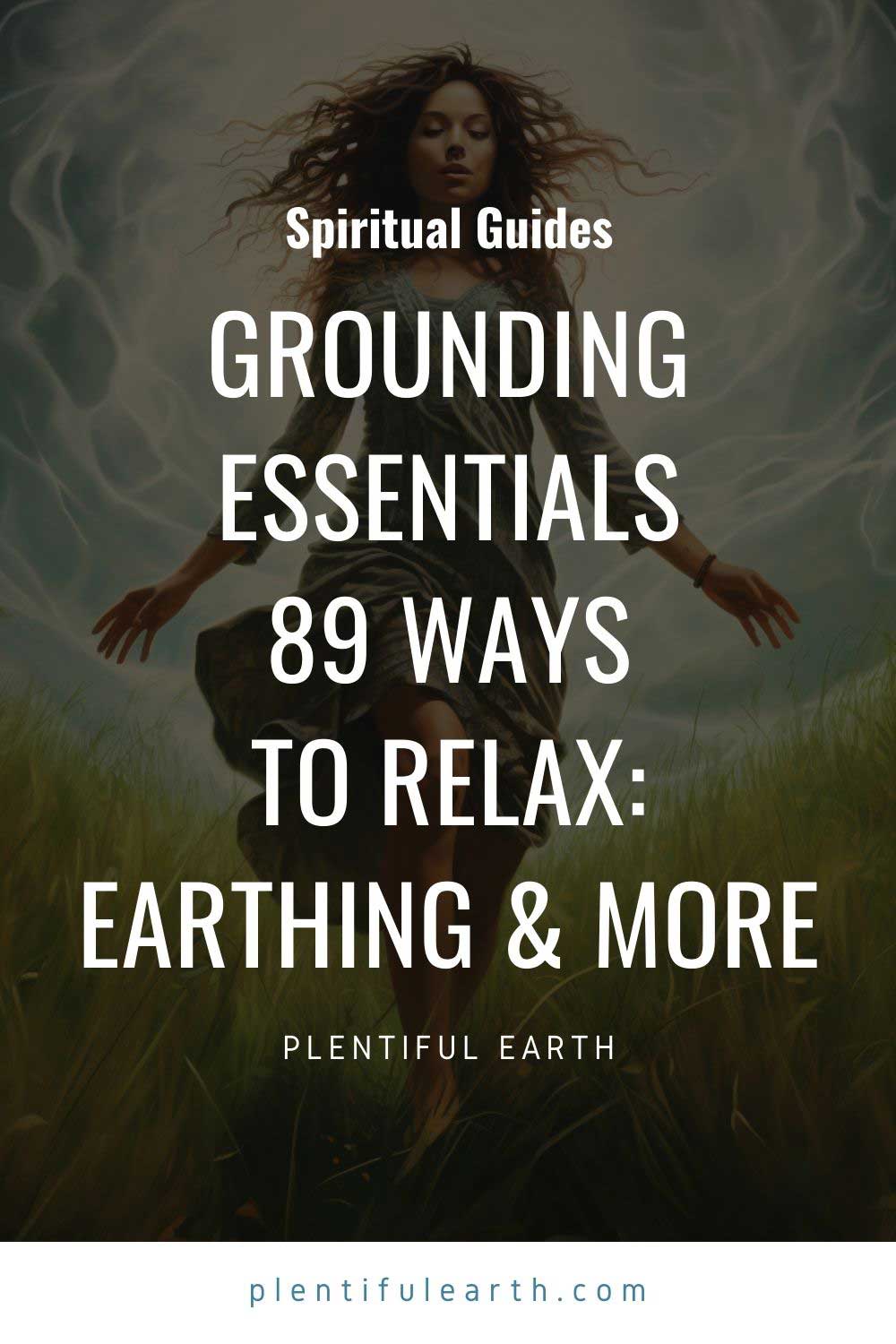Why do I feel so disconnected or spaced out lately?
What can I do to calm down fast when I’m stressed?
How can I feel less floaty after intense spiritual practices and rituals?
The answer is closer to you than you think. It’s right under your feet.
You just need to ground.
Grounding techniques and earthing techniques can help you connect to your body and the present moment.
Table of contents
Dozens of grounding methods can help you pull yourself back into your body. All you have to do is feel and focus, and we have different grounding techniques for you to try, right here.
89 Simple Grounding Techniques
A grounding technique is a method used to bring yourself back to the present moment and detach from overwhelming emotions or thoughts.
Grounding therapy, such as earthing therapy, involves cognitive and sensory exercises that focus on the here and now, such as deep breathing, mindfulness meditation, or engaging the senses (touch, sight, hearing, taste, smell).
The powerful grounding techniques below can help you manage stress and anxiety. The goal is to create a sense of mental and emotional stability by anchoring the mind in the present.
Mental Grounding Techniques To Reduce Anxiety
Mental grounding techniques are great for pulling your attention away from distressing thoughts, feelings, or memories, and towards mental tasks or activities that engage the brain.
These techniques are great for curbing anxiety, panic attacks, post-traumatic stress disorder (PTSD), or overwhelming emotions.
Mental grounding can help calm anxious thoughts and give you the space to breathe and think clearly.
The essence of mental grounding is to focus the mind on the present moment, often through specific tasks that require concentration or memory.

Try a calming exercise like:
- Counting Backwards: From 100 to 1.
- Naming Objects: Identify objects around you.
- Playing a Memory Game: Like “I Spy” or memory puzzles.
- Reciting Something: Like a poem or song lyrics.
- Planning an Event: Imagine that you are planning a trip or a party.
- Doing a Crossword or Sudoku: Engage your brain actively.
- Watching a Movie or Reading: Fully immerse yourself in the story with each of your five senses.
- Describing a Process: Walk your way through how to cook a dish or build something.
- Alphabet Games: Name animals, cities, etc., for each letter.
- Mindfulness Meditation: Focus on the present moment through each of your five senses.
- Visualizing a Safe Place: Imagine a calming, peaceful place that brings you a sense of calm.
- Drawing or Coloring: Concentrate on each of the lines and colors you add to your masterpiece.
- Writing: Journal your thoughts and feelings to get them out of your head and grounded onto physical paper.
- Solving Riddles or Puzzles: Engage in problem-solving.
- Playing Video Games: Choose immersive and calming games to pull your mind into something tangible.
- Building Something: Like a model kit or Lego.
- Listening to Music: Focus on the lyrics or melody.
- Practicing Gratitude: Think of things you’re thankful for.
- Brainstorming Ideas: For a project or a story.
- Repeating Affirmations: Positive and reassuring statements.
- Taking a Tech Break: Disconnect from digital devices.
- Listening to Nature Sounds: Like rain, waves, or birds.
- Doing Breathing Exercises: Like box breathing or 4-7-8 technique.
These types of exercises are great to help you stop an anxiety attack and emotional distress.
Physical Grounding Techniques
Physical grounding techniques are strategies designed to help you connect with your body and to the present moment through each one of your senses.
These techniques are super effective in managing stress, anxiety, and overwhelming emotions.
The key principle behind physical grounding is that it uses the five senses (touch, sight, hearing, smell, and taste) to anchor yourself in the current moment.

Try:
- Deep Breathing: Concentrate on taking at least one slow, deep breath. We love the box breathing method.
- Walking Barefoot: Feel the earth under your bare feet by practicing earthing. Focus on how the soil or grass feels beneath and between your toes. To ground quickly, try standing on concrete.
- Holding a Piece of Ice: Notice how the cold temperature feels on your hand. Pay attention to the melting process.
- Stretching: Do gentle stretches and pay attention to your body.
- Taking a Warm Bath or Shower: Take time to feel the water on your skin.
- Savoring a Flavorful Snack: Eat something and focus on its taste.
- Splashing Water on Your Face: Notice the sensation of coolness.
- Hugging a Tree: Feel its bark and the solidity of the trunk.
- Carrying a Grounding Object: A small worry stone, crystal, or a trinket to touch.
- Gardening: Feel the soil with your hands as you physically connect with nature.
- Dancing: Let your body move freely to the rhythm. Let go of anything that holds you back.
- Yoga: Practice poses mindfully and with all of your attention.
- Progressive Muscle Relaxation: Tense and release each muscle group one by one.
- Walking in Nature: Focus on the natural surroundings.
- Petting an Animal: Notice the texture of its fur and how it reacts to your touch.
- Clapping Hands or Stomping Feet: Feel the vibrations on your skin, in your muscles, and in your ears.
- Playing a Musical Instrument: Feel the instrument and the sound.
- Sitting in the Sun: Feel the warmth on your skin.
- Body Scanning: Mentally scan your body for sensations.
- Doing a Physical Chore: Like cleaning or organizing.
- Crafting: Engage in knitting, sewing, or other crafts.
- Cooking a Meal: Focus on the process and ingredients.
- Mindful Eating: Focus on the taste, texture, and process.
- Making Tea or Coffee: Focus on the preparation process.
- Practicing Self-Care: Activities that nourish you.
Spiritual Grounding Techniques
Spiritual grounding techniques are practices that connect you with a deeper sense of self, purpose, and often a higher power or the broader universe.
Don’t worry. These techniques are not religious.
Instead, they focus on nurturing the spirit or inner self, fostering a sense of peace, wholeness, and connectedness with all aspects of life.
Spiritual grounding is great if you are seeking inner harmony or a deeper connection with life’s meaning beyond the physical and mental realms. Try:
- Prayer: Regardless of religious beliefs, let your words and intentions make a new future.
- Meditation: Focused, open-ended, or guided meditation can help you reconnect to your Higher Self.
- Chanting or Singing: Spiritual songs or mantras.
- Spending Time in Nature: Connect spiritually with the environment.
- Reading Spiritual Books and Texts: Gain insight and peace.
- Practicing Loving-Kindness Meditation: Send goodwill to others.
- Mindful Walking: In a labyrinth or quiet space.
- Attending a Religious Service: Engage with a community.
- Lighting a Candle: Focus on the flame and its meaning.
- Practicing Tai Chi or Qigong: Gentle, flowing movements.
- Doing Charity Work: Feel a sense of connection and purpose.
- Reflecting on Life’s Big Questions: Existence, purpose, etc.
- Practicing Forgiveness: Towards yourself and others.
- Creating a Sacred Space: In your home or outdoors.
- Studying Philosophy: Explore different schools of thought.
- Volunteering for a Cause: Connect with a community.
- Performing Rituals: According to personal or cultural beliefs.
- Connecting with a Community: Spiritual or religious groups.
- Observing the Stars or Moon: Contemplate the universe.
- Engaging in Deep Conversations: About your spiritual journey or life.
- Bird and Animal Watching: Observe and identify different birds and animals, as well as how the commune with nature.
Emotional Grounding Techniques
Emotional grounding techniques are perfect for regulating your emotional states, particularly during times of heightened stress, anxiety, or emotional overwhelm.
These techniques aim to bring awareness to emotions and enable you to deal with them in a more balanced and controlled manner.
Emotional grounding is particularly useful when you are experiencing intense emotions, such as panic attacks, extreme anxiety, or emotional dysregulation. Try:
- Acknowledging Your Emotions: Identify and name your feelings.
- Talking to a Friend: Share your thoughts and feelings.
- Seeking Professional Help: Therapy or counseling.
- Practicing Compassion: Towards yourself and others.
- Crying When Needed: Allowing yourself to express emotions.
- Laughing: Watch a comedy or joke with friends.
- Screaming into a Pillow: To release pent-up emotion.
- Writing Letters: You don’t have to send them.
- Singing Loudly: Express yourself through song.
- Watching Inspirational Talks: Gain new perspectives.
- Creating a Vision Board: Visualize goals and dreams.
- Practicing Assertiveness: Communicate your needs clearly.
- Building Emotional Intelligence: Understanding emotions.
- Cuddling with a Loved One or Pet: Feel the connection.
- Art Therapy: Express emotions through art.
- Listening to Uplifting Music: Songs that boost your mood.
- Practicing Mindfulness: Being present in the moment.
- Engaging in Positive Self-Talk: Challenge negative thoughts.
- Doing Something Kind for Others: Generates positive feelings.
- Reflecting on Personal Achievements: Acknowledge your growth.
When Should I Use A Grounding Technique?
The frequency of grounding practices depends on your individual needs, lifestyle, and the specific challenges you might be facing.
There isn’t a one-size-fits-all answer, but here are some great beginner guidelines:
For General Well-being
- Daily Practice: Incorporating short grounding exercises into your daily routine can be beneficial. Even 5–10 minutes per day can make a significant difference.
- Morning Routine: Start your day with a grounding practice to set a positive tone for the day.
- Evening Routine: Use grounding techniques in the evening to unwind and promote relaxation before bed.
During Stressful Periods
- Increased Frequency: If you’re going through a particularly stressful or emotional time, you might benefit from grounding several times a day.
- Responsive Use: Use grounding techniques whenever you feel overwhelmed, anxious, or disconnected.
For Specific Conditions
- Anxiety or Panic Attacks: Grounding can be used as needed to manage symptoms. During an anxiety or panic attack, grounding techniques can be a crucial tool to regain control.
- Trauma and PTSD: For those with PTSD or trauma-related challenges, grounding can be a vital part of daily therapy and coping strategies, as recommended by a mental health professional.
How To Integrate Grounding into Activities
- During Breaks: Take short breaks during work or activities to practice grounding.
- Incorporate into Existing Routines: Blend grounding with activities you already do, like walking or showering.
Listen to Your Body and Mind: Pay attention to how you feel before and after grounding. Adjust the frequency based on what helps you feel more centered and less stressed.
How Long Should I Ground Each Day?
Short-Term Grounding (Quick Relief)
- Duration: 1–5 minutes
- Purpose: Ideal for quick relief from acute stress, anxiety, or overwhelming emotions.
- Techniques: Simple breathing exercises, mindful observation (like the 5–4–3–2–1 technique), or tactile methods like holding a grounding object.
Medium-Term Grounding (Focused Practice)
- Duration: 5–20 minutes
- Purpose: Useful for more in-depth relaxation and centering, especially if you have more time and a quiet space.
- Techniques: Guided meditation, deep breathing exercises, progressive muscle relaxation, or a short walk in nature.
Long-Term Grounding (Deep Engagement)
- Duration: 20 minutes to 1 hour or more
- Purpose: Suitable for deep emotional processing, spiritual grounding, or extensive stress relief.
- Techniques: Longer meditation sessions, yoga, tai chi, extensive nature walks, or engaging in a focused activity like gardening or art.
How Can I Ground Myself, Fast?
Our favorite method of grounding is one of the fastest: stand barefoot on concrete.
How Grounding Works To Calm You Down
Grounding techniques calm you down by engaging your mind and body in ways that bring your focus back to the present moment.
Grounding tends to be effective because it:
Redirects Mental Focus
- Distraction from Stress: Grounding techniques divert your attention away from stressors or upsetting thoughts, helping to interrupt and stop the cycle of anxiety or panic.
- Presence in the Now: By focusing on the present moment, grounding reduces rumination and worry about past or future events.
Regulates the Nervous System
- Activates Parasympathetic Response: Grounding exercises that involve deep breathing help stop your ‘fight or flight’ response by stimulating your parasympathetic nervous system.
- Lowers Stress Hormones: Grounding can reduce the release of stress hormones like cortisol, helping to alleviate feelings of anxiety.
Increases Body Awareness
- Mind-Body Connection: Techniques that involve physical sensation or movement increase your awareness of your body.
- Release of Physical Tension: Activities like stretching or progressive muscle relaxation help in releasing built-up physical tension, often associated with emotional stress.
Emotional Regulation
- Mindful Awareness of Emotions: Grounding techniques that focus on emotional awareness allow you to observe your emotions without becoming overwhelmed by them, facilitating a more balanced emotional state.
- Safe Emotional Outlet: Some grounding methods provide a way to process emotions in a controlled and safe manner.
Promotes Mindfulness and Concentration
- Enhances Focus: Grounding exercises often require concentration (like counting or engaging in a sensory activity), which can improve overall mental focus and clarity.
- Cultivates Mindfulness: Regular practice of grounding increases mindfulness, which is associated with reduced stress and improved mental health.
Provides a Sense of Control
- Self-Efficacy: Successfully grounding can increase your sense of control over your mental and emotional state, leading to greater confidence in managing stress.
Psychological Shift
- Cognitive Reframing: Grounding can also involve cognitive techniques that help shift your perspective on stressful situations, promoting more positive and less threatening interpretations.
Grounding works by addressing both the mental and physical aspects of stress and anxiety.
By breaking the cycle of distressing thoughts and emotional overload, you can actively manage your mental state.
Benefits Of Grounding
Grounding techniques and earthing offer a multitude of benefits, notably in reducing anxiety and stress by calming the nervous system and interrupting anxiety cycles.
They enhance emotional regulation, aiding in managing overwhelming emotions and facilitating their processing in a healthier way. Grounding also improves focus and concentration, increasing mindfulness and reducing mental clutter. Physically, it can relieve tension and promote better sleep.
For individuals dealing with trauma, grounding is particularly beneficial in managing dissociation and intrusive memories.
For some, grounding also deepens spiritual awareness, connecting them to a larger purpose or the universe.
The Spiritual Aspect of Grounding
Grounding for spiritualists after rituals is essential for transitioning back to everyday consciousness, balancing energy levels, and integrating spiritual experiences into practical life.
It ensures that the benefits of the ritual are maximized while maintaining a healthy balance between spiritual experiences and daily life.
Remember, grounding is a personal practice and can be adapted to fit your unique circumstances and needs. It’s more about the quality and practice than the quantity. If you’re unsure, or if you’re dealing with specific mental health issues, it might be helpful to consult with a mental health professional.




